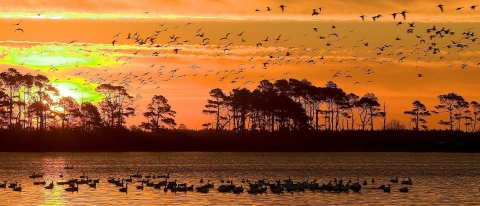Essential Habitats
More than one-third of the U.S. federally threatened and endangered species live only in wetlands, and nearly half use wetlands at some point in their lives. Numerous other animals and plants depend on wetlands for their survival. For many animals and plants, like wood duck, muskrat, cattail, and swamp rose, inland wetlands are the only places they can live. Coastal wetlands are key to the survival of many estuarine and marine fishes and shellfish as well as birds like the saltmarsh sparrow.
Most commercial and game fish breed and raise their young in coastal marshes and estuaries. Menhaden, flounder, sea trout, spot, croaker, and striped bass all depend on coastal wetlands. Shellfish like shrimp, oysters, clams, and blue and Dungeness crabs likewise need these wetlands for food, shelter, and breeding grounds.The U.S. Fish and Wildlife Service's (Service) Coastal Program promotes cooperative coastal conservation so that wildlife and people thrive. By facilitating voluntary collaborative conservation, the Coastal Program ensures a thriving and resilient future for coastal habitats, species, and communities.
A significant portion of important wetland areas are protected by the Service's National Wildlife Refuge System (NWRS), which consists of 570 individual system units across the United States, with the goal of conserving important habitat for the benefit of wildlife and citizens. Wetlands within the NWRS provide essential breeding, wintering, and stopover habitat for migratory birds and countless species of fish, mammals, and insects.
Did You Know?
- Up to one-half of North American bird species nest or feed in wetlands
- Nearly half of federally threatened and endangered species need wetlands for their survival
- Wetlands generate billions of dollars annually through popular activities, such as hunting, fishing, bird watching and photographing wildlife
- Although wetlands only cover approximately 5 percent of the land surface in the lower 48 states, they are home to 31 percent of plant species
Wetlands Are for the Birds
Wetlands and birds are inextricably linked—wetlands are homes and migration refueling places for one third of all bird species. Among the most productive ecosystems in North America, wetlands are biological “factories” of energy-rich resources vital to our birds. Many migratory birds stop by wetlands on the way to their winter or summer homes.
The Service's Migratory Bird Program is responsible for conserving migratory birds and their habitats. World Migratory Bird Day, which takes place on the second Saturday in May each year, celebrates the incredible journeys of migratory birds between their breeding grounds in North America and their wintering grounds in Mexico, Central America and South America. The event encourages bird conservation and increases awareness of birds through hikes, bird watching, information about birds and migration, public events, and a variety of other educational programs.
Federal Duck Stamps are a vital tool for wetland conservation. Since 1934, sales of the Duck Stamp to hunters, bird watchers, outdoor enthusiasts and collectors have raised more than $1 billion to conserve more than six million acres of habitat for birds and other wildlife and provide countless opportunities for hunting and other wildlife-oriented recreation on our public lands. Conservation of wetland habitat also supports numerous bird, mammal, fish, reptile and amphibian species that call wetlands home.



